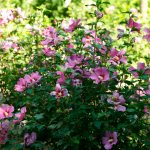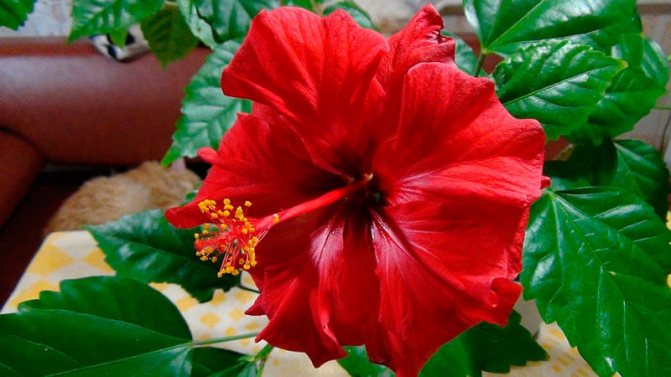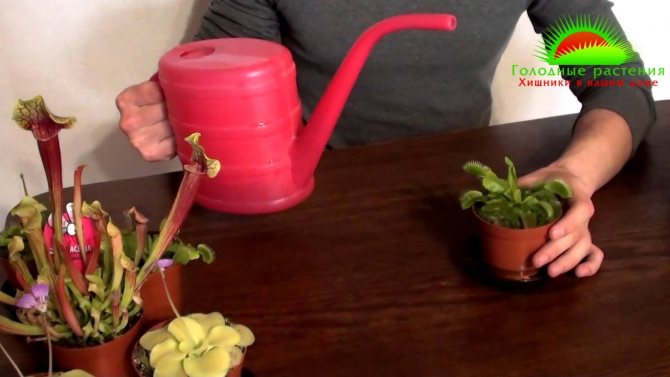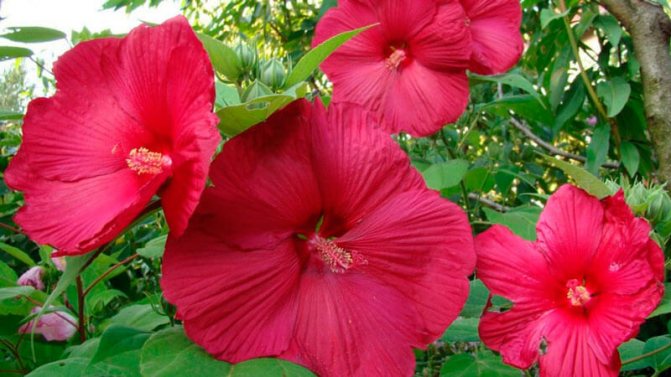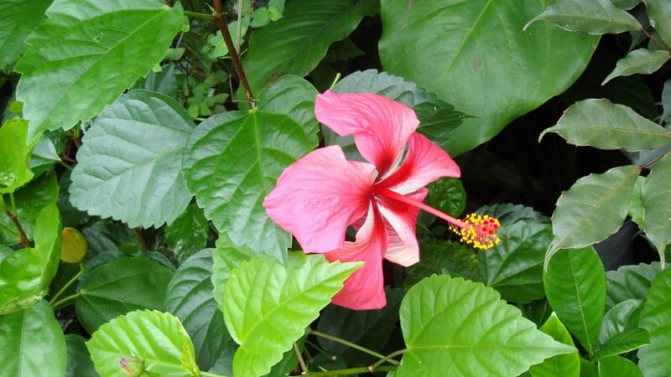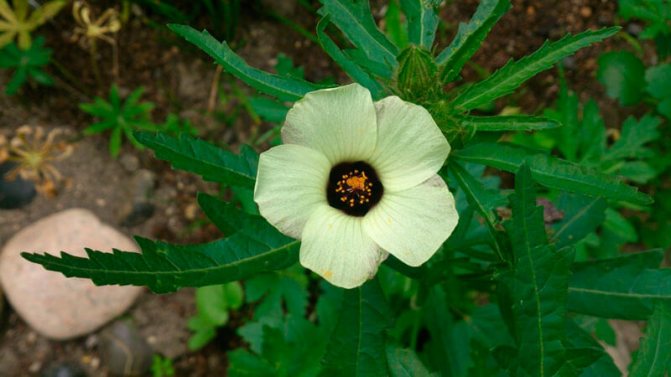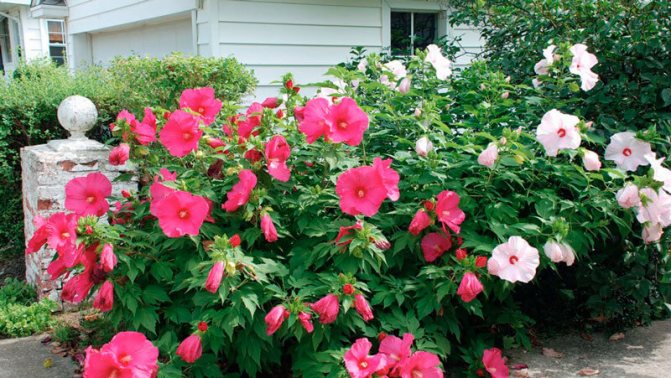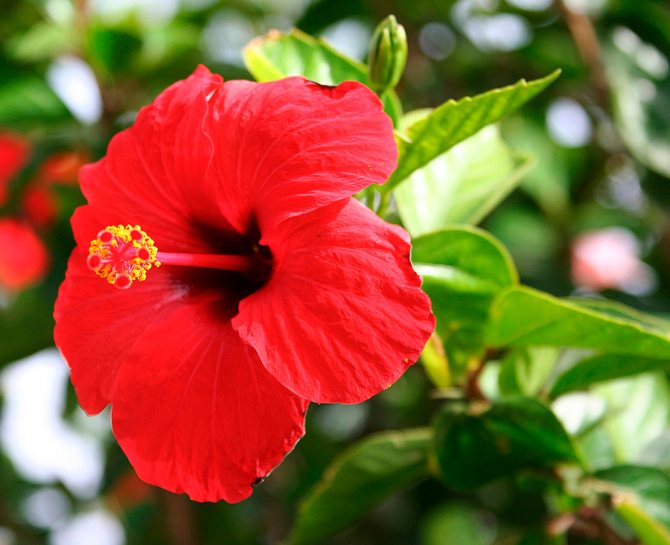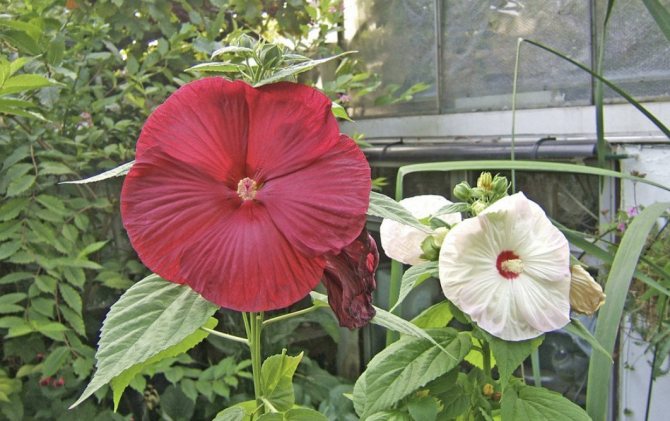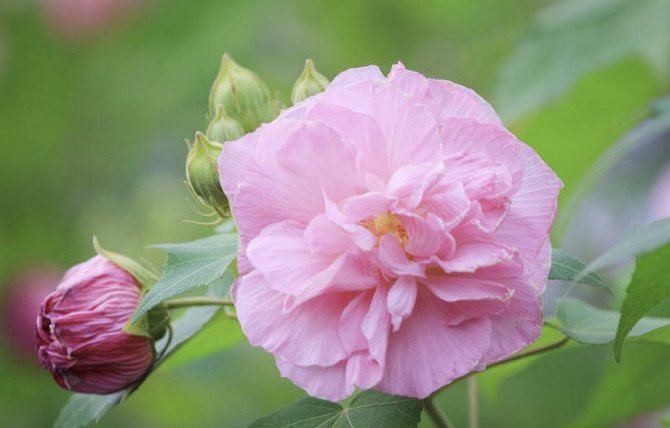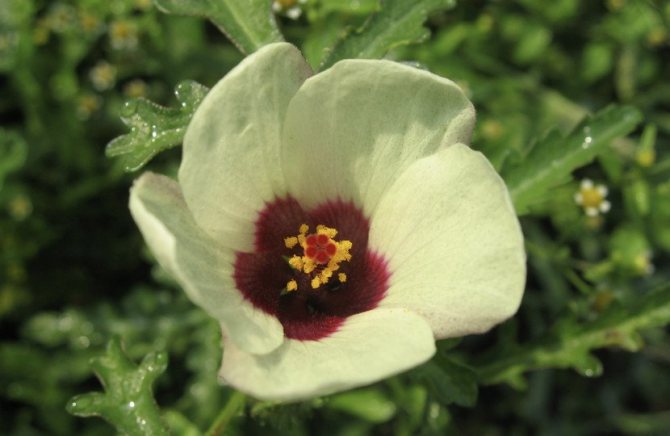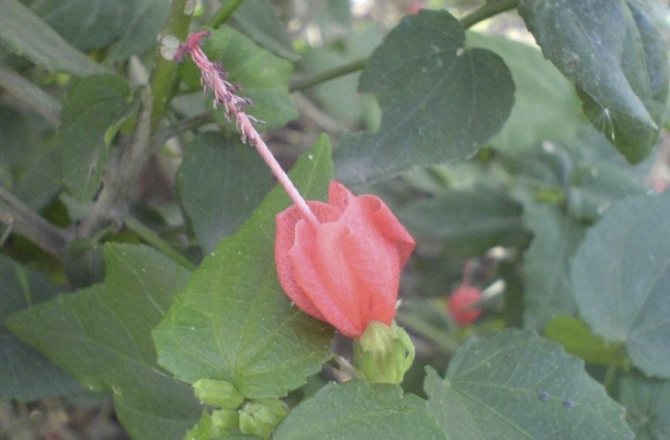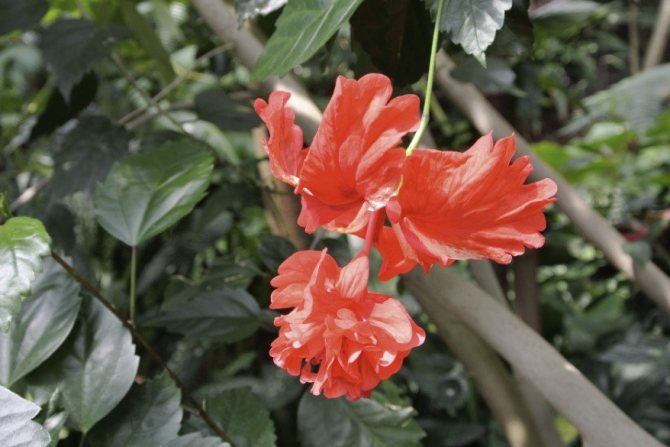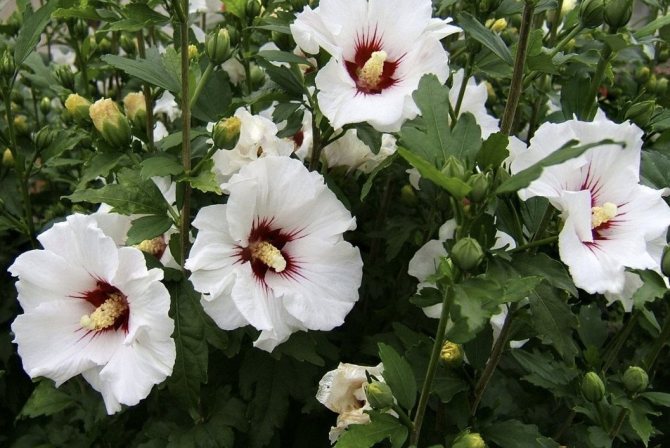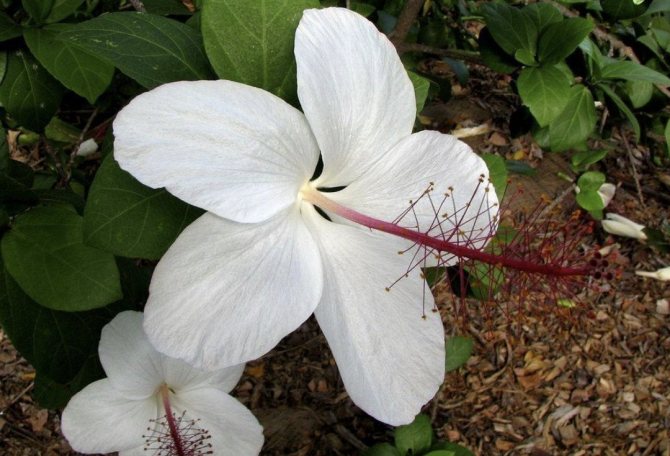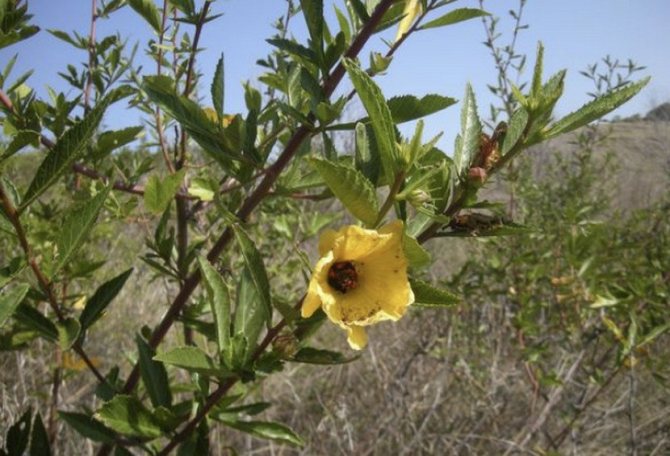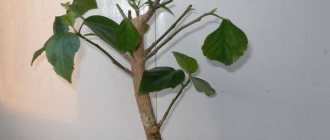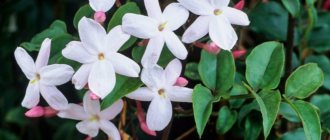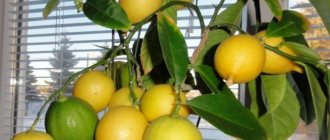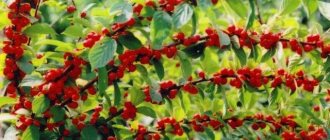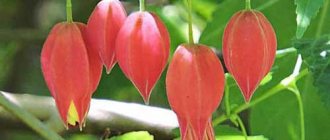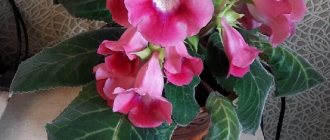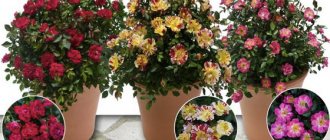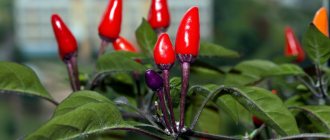Origin and appearance
The birthplace of the flower is considered to be China, Southeast Asia and Polynesia. In natural conditions, the plant is an evergreen shrub or tree, reaching 5 meters. At home, Chinese hibiscus is grown - this is also a bush or tree, but it can grow in room conditions only up to 2-3 meters.

Garden hibiscus
Its leaves are a bit like birch: they have denticles along the edge, a smooth sparkling corrugated surface of a dark green color, an elongated oval shape.
Single funnel-shaped inflorescences, at the time of full disclosure can reach 12-14 cm in diameter, in the middle there is a pistil, which may look like an elephant's trunk. Depending on the variety, there are different colors: white, yellow, red, pink and others.
Note! The life time of each flower is very limited: they fall off after 1-2 days, but in favorable conditions, the buds constantly replace each other from spring to autumn.
Description
Hibiscus is an evergreen shrub or slender tree, more than 2 m high. The trunk is woody, light brown or yellow. The foliage of the plant is similar in shape to birch leaves, the same shiny, with small teeth along the edge.
The flowering of the Chinese rose, judging by the photo, is beautiful: huge single flowers, up to 15 cm in diameter, are simple in shape (resemble an open bell) or double. There are hibiscus varieties with white, scarlet, lilac, yellow or pink petals. Each flower blooms for only one day, but, with proper care, new buds are formed without interruption from spring to late autumn.
Interesting. Dried flowers of one of the varieties of hibiscus - Sudanese rose, are the main component of Karkade tea, giving the drink a rich red hue.
Varieties
Thanks to Dutch breeders and flower growers from other countries, many varieties of the Chinese rose have been bred. The group of non-double large-flowered hibiscus "Sun City" is very popular:
- San Remo (white);
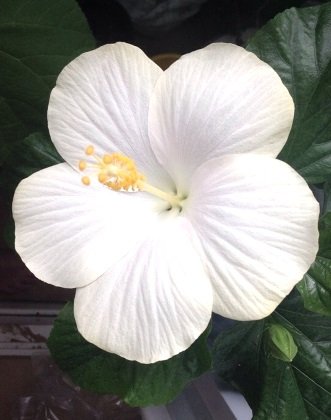

San Remo - Torino (orange);
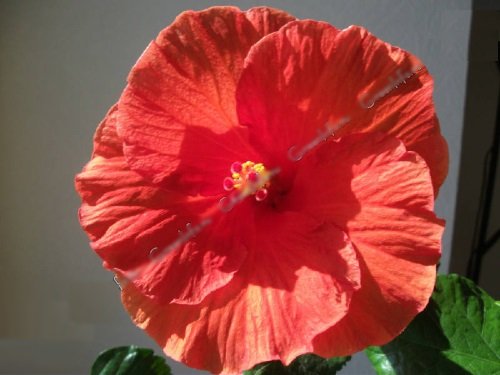

Torino - Tivoli (delicate pinkish-yellow flowers);
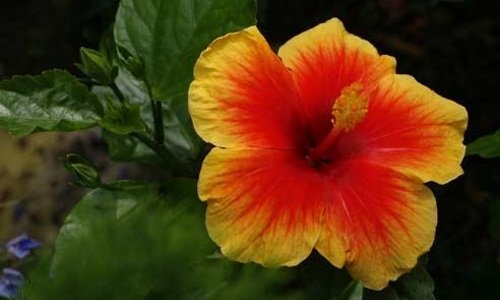

Tivoli - Porto (pure red);
- Borias (ruffled petals of a white-lemon shade, with a burgundy spot in Borias
Below are absolutely striking photos of blooming hibiscus of American flower growers. The so-called "Florida" hibiscus have purple, lilac shades unusual for natural flower forms:
- Carmen Keane (pink and lilac with white edging);


Carmen Keane - Filling Blue (soft lilac, with a dark center);
- Parl Majestic (dark pink with former streaks).
Of the representatives of the terry hibiscus, the King variety is recognized as the most popular. Its gigantic double bright yellow flowers cause genuine delight. However, the variety is quite capricious, if the rules of care are violated, it easily drops the buds.
Is it possible to keep a Chinese rose at home
Chinese rose - home care and reproduction
It is believed that hibiscus is the flower of death. This superstition is based on the fact that some plants rarely bloom, and a rapidly withering bud seems to bring death to the owner. In China, they try to get rid of the misfortune and burn faded inflorescences.Scientific research does not support these prejudices, so the flower can and should be grown at home. In many countries, other signs associated with the Chinese rose are known:
- Hibiscus is a flower of love and beauty.
- The presence of this plant in the house attracts the energy of love and tenderness, it is able to return old feelings to spouses with great family experience.
- The rapidly fading inflorescences absorb the diseases of the inhabitants of the house.
- Blooming hibiscus attracts grooms to their unmarried mistresses.
- The plant absorbs harmful substances and purifies the atmosphere at home.
- According to feng shui, the Chinese rose neutralizes black energy, protects households, and attracts goodness to the home.
- Parts of the plant have healing properties.
Types and varieties of Chinese rose
Balsam room - home care
According to some reports, there are over 250 representatives of the hibiscus genus. Chinese roses can be:
- evergreen and deciduous;
- tree and shrub;
- perennial and annual herbal plants.
For example, the Syrian hibiscus, which is considered the ancestor, is an evergreen perennial that grows both as a tree and as a shrub. Syrian hibiscus Matilda, planting and caring for which in the open field is simple and not laborious, adorns many household plots.


Swamp hibiscus
Marsh hibiscus and hybrid hibiscus are herbaceous plants, in which the ground part dies off in autumn, and grows back in spring.
Marsh hibiscus
Distinctive qualities of this variety:
- well-developed root system,
- heart-shaped leaves,
- grows up to 3 m in favorable conditions,
- blooms from spring to autumn,
- red, purple or purple buds up to 15 cm in diameter,
- each flower lives only 1 day, leaving behind a box of seeds,
- unpretentious in care.
Terry hibiscus
It is known why terry hibiscus is so called: because of the spectacular multi-layered flower. A very popular variety both in Europe and in the Moscow region, it can be grown both indoors and outdoors.
A large number of breeding varieties are known that are distinguished by high decorative qualities (for example, lilac-crimson Ardens or Syrian chiffon, which blooms in white (White variety), lavender or pink flowers).
Hibiscus mutable
Variable hibiscus is prized for the fact that its flowers change pink as they bloom.
Cooper's hibiscus
Cooper's hibiscus (named after the grower who first grew such a variety in England) belongs to variegated varieties, differs from others in that the color of its leaves changes depending on the quality of lighting, soil composition and temperature conditions. Also pleasing to the eye with beautiful inflorescences.
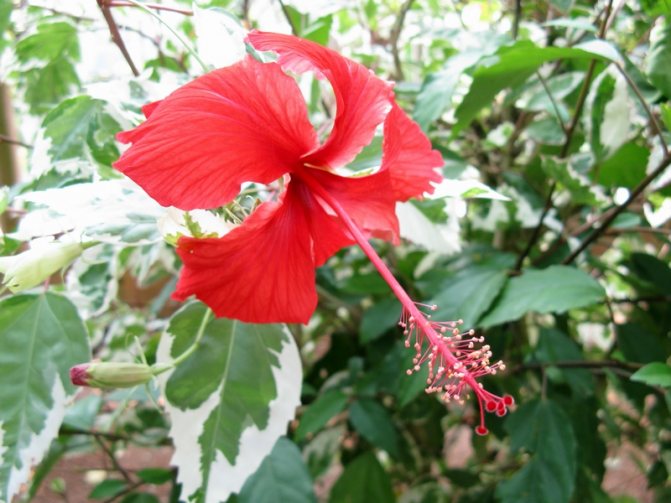

Cooper's hibiscus
Variegated hibiscus
Breeders have bred a large number of variegated varieties that differ from each other in the shape and color of both leaves and flowers. Some plants can simultaneously show foliage of different colors and shades: some leaves are green, others can be with red, white or yellow tints.
Hibiscus white
White hibiscus attracts with its tenderness and aesthetic appearance. There are many varieties, differing in appearance, preferred location and growing conditions.
Hibiscus red
Red hibiscus is the most common variety, easy to care for, can grow both at home and outdoors.
Hibiscus yellow
Yellow hibiscus is common in countries with cool climates (possibly due to the warm, sunny color). Many varieties have been bred, both simple to cultivate and delicate ones that require special care.
Community of green men
Hibiscus Hibiscus, Chinese rose, Chinese rose, marsh mallow, "the flower of beautiful ladies". Evergreen trees or shrubs with large simple or double flowers of various colors (white, yellow, orange, lilac, all shades of pink and red, there are also bicolor varieties).
Etymology
The genus has the ancient Greek name for the stock-rose Alcaea rosea.
Types and varieties of hibiscus
The genus includes over 250 species of evergreen trees, shrubs and herbaceous perennials, common in tropical and subtropical regions.
Hibiscus is native to tropical Asia and southern China, but it grows freely in Africa and America. In Brazil, the hibiscus diversified, or "princess earrings" grows, in Hawaii, hibiscus is considered a national plant and is called "the flower of beautiful women."
In places of growth, hibiscus are used not only as excellent ornamental plants, their young shoots and leaves are used for food. The seeds, fruits, roots and leaves are used medicinally.
Chinese hibiscus, or Chinese rose, Chinese rose tree (Hibiscus rosa-sinensis)
Homeland - Southeast Asia and Polynesia. The species was introduced to Europe at the end of the 17th century.
It is a shrub or tree in nature up to 4–5 m tall (in culture up to 2 m) with large leaves up to 10–15 cm long, oval, shiny, dark green. Variegated forms are found.
Already at a young age, hibiscus begins to bloom profusely. Flowers are solitary, 10–12 cm in diameter, white, yellow, pink, red or purple. In the initial species, the flowers are simple, in hybrids they are often double.
Each flower lives only 1 day. However, the plant can bloom throughout the year.
Currently, about 500 varieties are known.
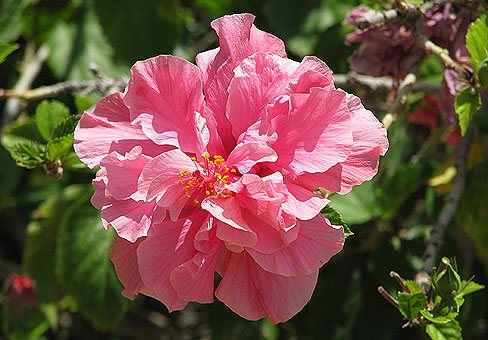

Popular varieties of Chinese hibiscus:
Hibiscus 'Alicante' - flowers are simple, red;
Hibiscus 'Ankara' - flowers are simple, yellow with a red core;
Hibiscus 'Rosa' - semi-double flowers, pink;
Hibiscus 'Flamingo' - flowers are pink with a dark core, simple;
Hibiscus 'Paramaribo' - flowers are red, simple;
Hibiscus 'Rio' - pink flowers with a dark center, simple;
Hibiscus ‘Koenig’ - yellow flowers, double;
Hibiscus 'Bangkok' - yellow flowers with a maroon center, simple;
Hibiscus 'Bari' - flowers are light yellow with a dark center, simple;
Hibiscus 'Sunshine Purple' - deep pink flowers, simple.
Hibiscus mutable (Hibiscus mutabilis)
An attractive ornamental semi-deciduous shrub or small tree about 3-5 m tall with an umbrella crown in an adult plant and large (about 20x20 cm), velvety dark green five-lobed serrated leaves.
Syrian hibiscus, or ketmia, or Syrian rose (Hibiscus syriacus)
A shrub up to 4 m in height, native to China and India, with bright green leaves and flowers of various colors, surviving up to 100 years. Blooms from mid-summer until frost. Flowers up to 10 cm in diameter, color from white to crimson and even lilac with a burgundy center. Depending on the variety, flowers can be simple and double, there are also unusual variegated varieties. With proper care, hibiscus is literally strewn with flowers. And although each flower lives only one day, due to the abundance of buds, the flowering of the bush is very bright and long-lasting.
Quite a demanding type of hibiscus, suitable for growing in winter gardens and on insulated loggias.
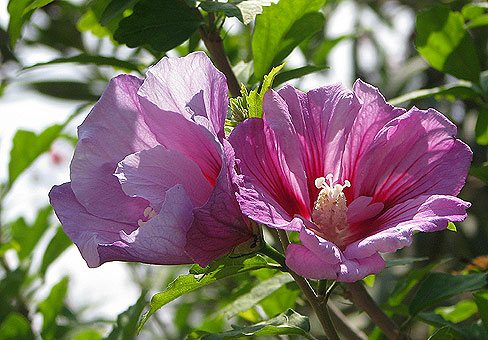

Syrian hibiscus has now become often sold as a garden plant for central Russia. Unfortunately, this southern plant does not winter with us, even under cover.
Hybrid hibiscus, or herb hibiscus (Hibiscus hybridus)
The species was obtained by crossing three North American species - Red Hibiscus (Hibiscus coccineus), Pink Hibiscus (Hibiscus moscheutos) and Holly Hibiscus (Hibiscus militaris).
The plant is suitable for growing in hydroponic culture. Excellent bonsai are made from hibiscus, this plant tolerates pruning well.
Popular varieties of hybrid hibiscus:
Hibiscus 'Albus' - flowers are single, large, white;
Hibiscus 'Coelestis' - narrow and upright shrub with short shoots, single flowers, violet-blue;
Hibiscus 'Diana' is an upright shrub up to 2 m tall, flowers up to 12 cm in diameter, pure white, petals with wavy edges. Abundant flowering;
Hibiscus 'Hamabo' is a rather tall shrub, single flowers, pale pink with a reddish tinge or stripes in the lower half of the petals;
Hibiscus ‘Lady Stanley’ is a thin, narrow shrub, semi-double flowers, white with a pinkish tinge, dark red in the center. Blooms moderately;
Hibiscus 'Pink Giant' - flowers are single, uniformly pink with a dark red spot at the base. Differs in abundant long-term early summer flowering;
The ‘Russian Violet’ hibiscus is a vigorous growing shrub. The bloom is very abundant, the flowers are dark pink;
The 'Violet Elar Double' hibiscus is a powerful upright shrub. The flowers are double, less often semi-double, violet-blue with one or more red spots.
Hibiscus trifoliate (Hibiscus trionum)
A herbaceous plant native to North and Central Africa.
The species is grown as an annual in the garden.
Taproot, straight stem, branched, 20–80 cm high. Leaves are alternate, tripartite, petiolate, pubescent.
The flowers are pale yellow with a purple center up to 4 cm in diameter. They open in the morning for only a few hours, and in the afternoon they are already closed. However, the flowering period of this plant lasts more than a month, as new buds form in the axils of each leaf. If the conditions are right, flowers will appear every day. After the corolla falls off, a bloated fruit forms on the peduncle. Dried shoots with unusual fruits are good in dry bouquets.
Hibiscus grows well in indoor culture. It is very popular with flower growers. A wide variety of shapes and varieties are used in indoor landscaping. Hawaiian hybrids are distinguished by large flowers (13-15 cm).
Hibiscus care
Unpretentious plant in room culture.
Place the hibiscus in a bright place. In winter - in the light at a temperature of + 15 ... + 20 ° C. Watering during the growth period is abundant, in winter it is limited.
Until mid-August, weekly feeding is required; in winter, feed no more than once a month with a warm placement.
In the spring, overgrown plants are shortened by half the main shoots. Pruning is always done over the already formed bud. Reacts to change of location - can shed foliage.
Young plants are transplanted every year in the spring, while pruning and thereby stimulating the appearance of a large number of young shoots on which flowers are formed. It is better to replant adult plants every 2-3 years. Large specimens prefer wooden tubs. If the pot is too large, the hibiscus will form new leaves, but will not bloom. For planting, a soil mixture of leaf and sod land, compost, sand (1: 1: 2: 1) is used. The addition of bone meal is desirable.
Possible problems:
- leaves fall - possible reasons: drying out of the soil or vice versa waterlogging, drafts are also possible;
- buds fall off - the most likely reason is drying out of the soil. Other possible causes include nutritional deficiencies and sudden temperature changes;
- the leaves shrivel - the reason, as a rule, is dry air. Spray the plant more often in the summer;
- on the inside of the leaf pads appear from a mass of spores of yellow, orange or brown color - the reason: rust. Remove speckled leaves, isolate the diseased plant, and spray with synthetic fungicides.Repeat the treatment every week for a month;
- pests - can be affected by whiteflies, aphids and spider mites, in order to prevent this, hibiscus must be periodically sprayed and washed with warm water.
Reproduction of hibiscus
Hibiscus is propagated by green and semi-lignified cuttings in February, March and August in a substrate consisting of nutrient soil, at a temperature of + 20 ... + 25 ° C. Cuttings can be treated with phytohormones to stimulate root formation. When rooting, cover with a glass jar or plastic bag.
Hibiscus in home ecology
Actively enriches the air with phytoncides and humidifies it. Humid air contains 40-50% less dust than dry air. Plants that humidify the air significantly reduce the risk of developing respiratory diseases and help to improve the general condition of the human body. Hibiscus not only moisturizes the air, but also creates a healthy “electrostatics” that enhances performance. In addition, the plant has the ability to absorb and decompose trichlorethylene (this is a colorless liquid that smells of chloroform, which is part of varnishes, glue, evaporates easily and is considered carcinogenic).
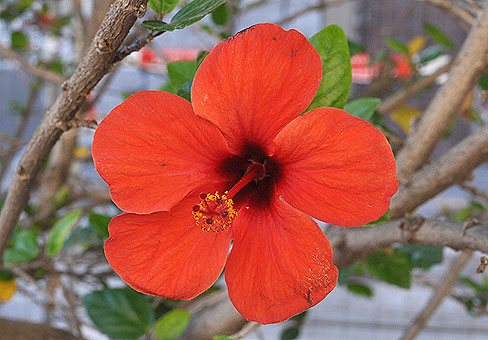

Like any flowering plant, it creates an aesthetically pleasing and comfortable environment. The "heart" of this plant contains nectar, which is considered an aphrodisiac, so it is worth thinking, dear women, about putting this "flower of love" in your bedroom. The presence of this plant will add charm to the room, and in the summer seasons will fill it with a unique aroma.
The healing properties of hibiscus
The history of using hibiscus for medicinal purposes goes back several millennia. In Egypt, hibiscus seeds were used to cleanse the breath, and an emulsion of butter with milk was used to relieve itching. The Arabs mixed hibiscus musk seeds with coffee. In the East, seeds are used as a seasoning for food. Taiwanese know hibiscus seeds as a diuretic, laxative and tonic. In the Philippines, hibiscus sour root is used as an appetite-boosting tonic. Angolans recommend hibiscus leaves as a softening drink for coughs. The leaves, stems, calyxes and fruits of the plant are edible.
Currently, the plant is used in the food and pharmaceutical industries. Dark red fleshy buds and cups form the basis of hibiscus tea, and contain various organic acids such as malic, tartaric, citric. Therefore, the tea drink prepared from them has a pleasant sour taste, which perfectly quenches thirst. Anthocyanins, which give the drink a red color, help to strengthen the walls of blood vessels and ensure their permeability.
The flavonoid quercitin, contained in hibiscus, enhances the action of anthocyanins, helps to cleanse the body.
Most diseases are known to be caused by fatty deposits in blood vessels, which thicken the walls and obstruct blood circulation. The main means of fighting cholesterol deposits is gamma-linoleic acid, which dissolves fat deposits. Karkade tea (hibiscus tea, mallow tea, Sudanese rose, hibiscus tea) Is one of the most natural natural sources of gamma-linoleic acid.
Hibiscus energy
Hibiscus flowers have a strong love energy. If you follow fairly simple rules of care, the plant can bloom for a long time, contributing to the creation of harmony in the house. Especially the content of this plant will be useful for couples who have lived together for many years. Blooming hibiscus will help restore the extinguished flame of feelings, ignite your hearts with passion. Hibiscus is characterized by upward spiral vibrations of energy.Energy flows from the roots of the plant into the stem, around it in a spiral to the tips of leaves and flowers, enveloping the flowers in wide diverging circles.
Hibiscus in flower cooking
Hibiscus sabdariffa (Hibiscus sabdariffa), hibiscus sabdariffa, karkade is used to obtain a tea drink with a sour taste and a beautiful rich red color. Dried flower cups are used for tea. The hibiscus drink is excellent thirst quencher and has beneficial properties.
They are brewed like tea, do not boil, with prolonged heating, the coloring matter decomposes, and the drink becomes dirty gray. It is also important to use glass or porcelain dishes when brewing. When in contact with metal, the taste and color of the drink deteriorates. The infusion can turn green when brewed with very hard water. Moreover, the sepals of hibiscus softened in water do not lose their original sweet and sour taste, and therefore they can be eaten as an excellent vitamin supplement, which, due to the high content of vitamin C, protects the body from viral infections.
For Russians, hibiscus tea can be recommended taking into account the climatic conditions, which are characterized by a seasonal lack of vitamins in the body. Serious contraindications of karkade tea have not been identified, but, nevertheless, it is necessary to use it carefully and in moderation if individual intolerance to some products has previously been noted. The restriction on the use of karkade tea applies only to children under 1 year old. Hibiscus can also be used as a weight loss aid.
Interesting facts about hibiscus
The hibiscus flower is very popular in many countries. There is a red hibiscus flower on the coat of arms of Malaysia, and in the capital of this country there is the most beautiful Hibiscus Park, where more than two thousand copies of this plant grow. Moreover, hibiscus is a symbol of the island of Haiti. Local women and numerous tourists adorn themselves with its flowers. In India, they are woven into wedding wreaths.
Pages of history
Interest in hibiscus first arose in Hawaii, from where this plant was subsequently introduced to Europe. And already at the beginning of the 18th century. hibiscus has adorned some European botanical gardens, captivating visitors with lush bloom. In 1950, the American Hibiscus Society was formed.
Hibiscus in the world
Hibiscus in Malaysia
Malaysia is a multinational country. The population of Malaysia exceeds 22 million people and has more than 60 different ethnic groups, the largest part being Malays. They are Muslims, speak Bahasa and are the most politically active part of the country. There is a red hibiscus flower in the coat of arms of Malaysia. With hibiscus petals in Malaysia, women used to draw their eyebrows, and a decoction from its roots was used to treat many diseases. The capital of Malaysia, Kuala Lumpur, is often called simply Key El - "City of Gardens and Lights". There, around a picturesque lake, not far from the center, there are several parks. The parks are decorated with flower beds, shady alleys, playgrounds and all kinds of jogging paths. The Orchid Park, which has more than three thousand species of these beautiful flowers, smoothly merges into the Hibiscus Park. More than two thousand specimens of this beautiful flower, which is a national symbol, grow here.
Hibiscus in Egypt
In Egypt, tea made from cups of karkade (red tea) is the national Egyptian drink and has been consumed since time immemorial. Hibiscus seeds were used to cleanse the breath, an oil-in-milk emulsion to relieve itching.
Hibiscus in Haiti
The original exotic hibiscus flower is the symbol of the island of Haiti. Locals and numerous tourists adorn themselves with it.
Hibiscus in India
In some provinces of India, red and pink flowers are woven into wedding wreaths.
Hibiscus in Brazil
In Brazil, there is a diversified hibiscus called "princess earrings". It has split petals and a long peduncle on which it sways gracefully, truly resembling an exquisite earring.
Hibiscus in Argentina
Hibiscus is a very popular plant in Argentina. In Buenos Aires, one or another of its varieties grows in the front garden of every third house, blooming, with short interruptions, almost all year round, hanging its flowering branches over the sidewalk from behind the fence of houses. Numerous hybrids and breeding varieties of this species, with simple and double flowers, and sometimes with small variegated white-green leaves, are so widespread in South America that one might think that this is their homeland.
Hibiscus and hibiscus: what's the difference
Karkade red tea is made from hibiscus. But inflorescences of only one specific variety are suitable for these purposes - the Sudanese rose. Flowers of plants of other varieties have some healing properties, but they do not have such a rich sweet-sour taste and red (or burgundy) color.
In addition, hibiscus is a plant, the word "karkade" is used to refer to a part of a flower and tea from it. The Sudanese rose is also called Roselle, Red Shavel, Sharon rose or Rosella, the scientific name is hibiscus sabdariffa. This variety is not suitable for home cultivation.
Transplanting a plant after buying into a pot
A plant purchased from a flower shop needs a transplant, since for transportation all plants are transplanted into a temporary pot and lightweight soil. After 10-12 days, when the plant adapts to new conditions, it must be transplanted into a new container.
What is needed for landing
For a transplant you need:
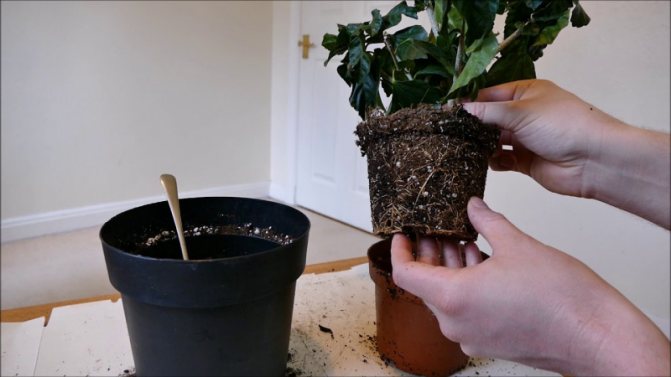

Chinese rose transplant
- A suitable pot, slightly larger than the one the plant is currently in. Ceramic is ideal.
Important! You cannot plant a Chinese rose in a metal container.
- Transplant soil. You can buy ready-made or cook it yourself by mixing turf, leaf or pine soil with humus, sand, peat and a small amount of charcoal or vermiculite.
- Drainage (small pebbles, expanded clay or broken brick).
- Water.
Optimal location
The optimal place for placing a Chinese rose is warm (but not next to heating appliances), without drafts, with soft diffused light.
Step-by-step planting process
The best time to transplant is spring.
Landing order:
- A small layer of drainage is poured into the bottom of the new pot (the height of the layer depends on the size of the plant and the pot). Add a small layer of soil.
- Slightly moisturize the soil under the plant.
- The roots are carefully removed along with a clod of earth.
- If a transshipment is made, then the whole earthen lump is placed in a new container. When transplanting, the old soil is carefully shaken off, the root system is examined, damaged or diseased roots are removed, then the roots are placed in a pot.
- They fill up the free space with prepared soil, tamp the soil a little with their hands.
- Water the plant and return it to its usual place.
Note! Young plants are replanted annually. Large trees can be replanted once every 3-4 years, or if the pot becomes small for hibiscus.
Disease and pest control
One of the most frequently asked questions when growing a Chinese rose is why the plant doesn't bloom. There are many reasons for this problem. But they are all due to the fact that the conditions of the plant are too different from natural ones. For example, a lack of flowering can be caused by:
- lack of lighting;
- high air temperature (hibiscus buds begin to form at a temperature of +15 ° C);
- excessive watering (when the plant comes out of the dormant period and is ready to bloom, the earth does not need to be waterlogged - otherwise the bush will begin to actively form a green mass to the detriment of flowering);
- violation of development phases (if the Chinese rose is not provided with a full-fledged dormant period in winter, the flowering program for the next year will not be formed);
- too large a pot (for all flowering plants the same rule applies: they should be a little crowded in a flowerpot. The plant will not bloom until its root system fills the entire space of the pot);
- improper pruning or its absence (the Chinese rose lays buds only on the upper young shoots; to stimulate their growth, the old ones must be constantly shortened);
- lack or imbalance of nutrients in the soil (this can be a deficiency of phosphorus and an excess of nitrogen).
Also, the leaves of the Chinese rose quite often fall or turn yellow.
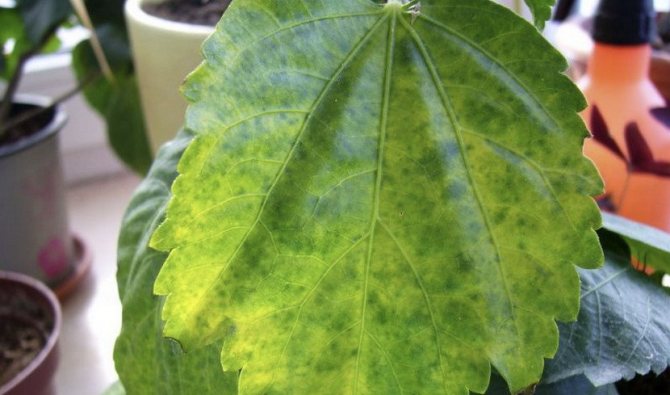

The first symptom is most often associated with a drop in temperature below the permissible limit. As for the second indicator, here we are talking about the wrong composition of the soil or a gross violation of the irrigation technology. In such a situation, experts advise to transplant the flower into a suitable substrate for it and water it with slightly acidified water.
The diseased plant is fed with iron (and it is better to apply it not at the root, but by spraying the leaves). For these purposes, you can use one of the proven drugs:
- "Micro-Fe";
- Ferovit;
- Ferrilene;
- Iron chelate;
- Brexil-Fe;
- "Antichlorosis".
Important! Chlorosis is the scientific name for the disease, which is expressed in the yellowing of the leaves of a plant. It is caused by a lack of chlorophyll in the leaf plate (gives the leaves a green color) and iron.
Sometimes the Chinese rose is attacked by pests. Most often, infestation occurs from other indoor plants, although untreated soil can also be the source of the problem. The parasite can be carried into the room by the wind, as well as get on the flower from the hair of a pet or household clothes.
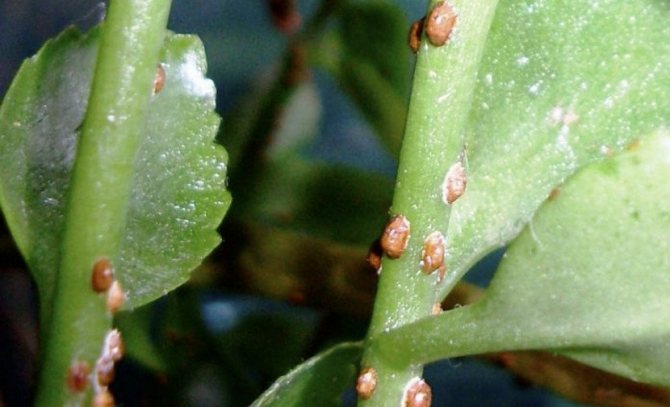

Among the most dangerous pests for the Chinese rose are often called:
- aphids;
- shield;
- mealybug;
- spider mite;
- thrips;
- whitefly.
Some of the above parasites are so small that it is almost impossible to see them with the naked eye. As for the traces of their vital activity, it is not always possible to accurately identify the pest from them.
But the measures to combat all insects infecting indoor plants are very similar. When the first signs of a problem appear (spots on the leaves, plaques, cobweb threads, sticky streaks), the leaves and stems of the Chinese rose should be thoroughly washed with soap or alcohol solution (or treated with gruel from laundry soap and grated onion / garlic). Make sure that such a mixture does not get into the soil. If the disease progresses, the flower must be treated with a special preparation.


It is better to purchase universal remedies that are equally effective against insects and ticks:
- Akarin;
- Actellik;
- Aktofit;
- Apollo;
- "Vermitek"
- Fitoverm;
- "Fufanon".
Hibiscus is an unpretentious plant. Keeping it as an indoor flower will not be difficult. However, in addition to the correct temperature regime, lighting, watering and feeding, you need to master the technology of formative pruning.
For those who are not superstitious and not afraid of blooming in their own bedroom blood-red "flower of death", this plant will help turn a dull city apartment into an island of a real rainforest.
Reproduction of the Chinese rose
Chinese roses can propagate in two ways:
- cuttings,
- seeds.
Cuttings
Cutting order:
- cut off young branches (at least 4-5 leaves) and place them in water or wet sand;
- within 2-3 weeks, the cutting takes root;
- transplant the seedling into a permanent pot of a suitable size;
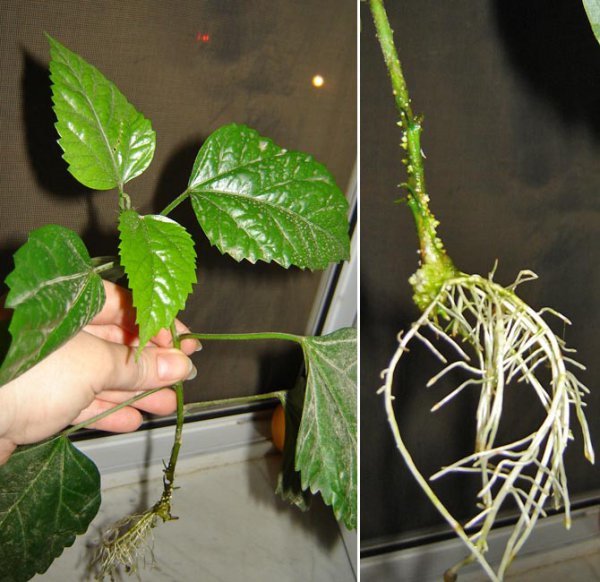

Chinese rose cuttings - planted in open ground no earlier than June.
Growing from seeds
Sowing sequence:
- The seeds are soaked in a growth promoter for 12 hours.
- Sow in prepared soil.
- Cover the container with foil and place in a warm, dark place.
- The emerging seedlings are rearranged to a sunny place and grown to 3 permanent leaves.
- Seedlings are transplanted separately.
How to grow a room rose from a bouquet
You can grow an indoor rose from a flower in a bouquet. But for this you need to follow some rules.
Variety
For this purpose, only domestic mini-roses are suitable, preference should be given to those that have flowers of red or pink tones - they take root most easily. The stem must be thick and strong, the leaves and buds must be alive.


Period
Cutting is permissible from late spring to mid-autumn. The water in the vase with the bouquet is changed every day.
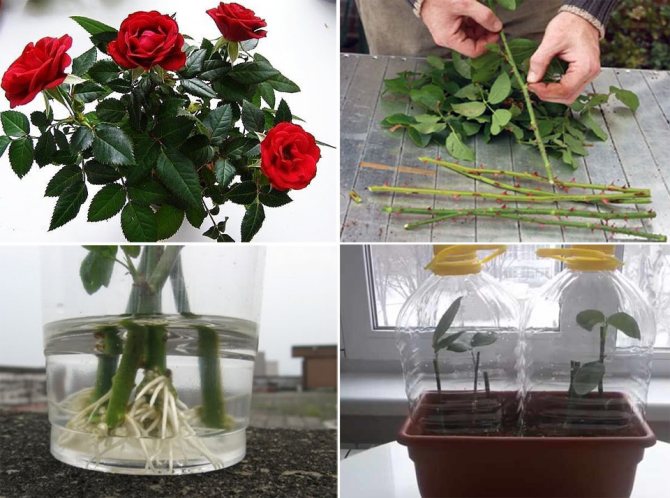

At night, the stems are dipped completely into a clear liquid, buds down.
Cuttings
The secateurs are pre-disinfected. The shoot is cut into cuttings 10-15 cm long. At least three buds are allowed. 1.5 cm recede from the bottom and make an oblique cut, and at the same distance from the top - a straight line.
The leaves should also be preserved, they are also usually cut off by one third.
As a last resort, it is permissible to use a cut half as short with one bud.


Rooting in water
A biological growth stimulant is added to warm water, for example, Epin or Kornevin.
You can use honey instead (1 teaspoon per glass of water) or juice from aloe stalks (up to 20 drops). One third of the planting material is placed in the solution and kept in it for up to three weeks. The water is changed every five days.
The first small roots usually appear by the end of the second week. During the third, they grow a little.
Rooting in the ground
If the roots have grown by 2-3 cm, you can plant a young shoot in the ground.
To do this, take small cups (up to 300 ml) filled with a mixture with an earthy composition for roses. At the bottom, drainage is pre-poured with a layer of about 1.5 cm from sand or small shells.
The container with the planted shoots is covered with something to create a greenhouse effect. A glass jar or cut-off plastic bottle will work.
At +25 ° C, high humidity and optimal soil, the plant takes root quickly.
Rooting in potatoes
This method gives 90% results.
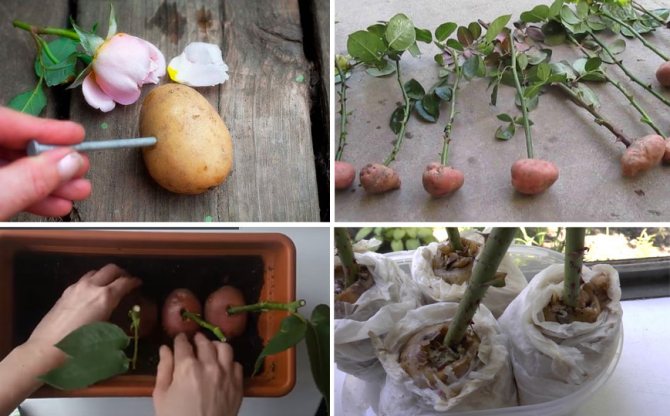

- They take large potatoes, wash them, remove the eyes.
- Placed in a solution of potassium permanganate for a few minutes, take out and dry.
- With a sharp disinfected knife at an angle of 45 degrees, a depression is made in the tuber.
- Take cuttings dipped in Kornevin and insert into potatoes.
- Tubers are placed in a container with soil, deepening them by 15 cm, sprinkled with earth, leaving the upper buds above the soil.
- Cover with a transparent film or jar.
- Periodically watered with a nutrient mixture (1 tsp sugar per 1 liter of water).
- The sprouts are released from the greenhouse after 2 weeks.
Burrito rooting
This is a very unusual way. Rose cuttings are soaked in water, then wrapped in wet paper, put in a bag. From time to time, the packaging is opened, aired, rotten scraps are looked at and removed, and the newspaper is changed. After the roots appear, the cuttings are pruned so that no more than 4 buds remain, planted in the ground.


Young plants must form a root system, so the emerging buds must be removed for the first year. Propagation by cuttings in autumn allows you to grow a full-fledged flowering indoor rose bush by the next season.
Hibiscus care
Hibiscus is unpretentious, caring for it at home does not require special skills and abilities.
Watering mode
The Chinese rose does not store moisture for future use, so the plant is watered regularly. Abundant watering is carried out in the morning, but moisture is poured out of the pan, as it can lead to acidification of the soil.
Top dressing
For feeding, a universal complex fertilizer is used, in which there is enough nitrogen and calcium. Fertilizers are applied in liquid form.
Important! It is undesirable to apply phosphorus fertilizers, since this element poisons the plant and negatively affects its decorative properties.
During flowering
During the period of active growth and flowering, the flower is fed in small portions weekly. When applying fertilizers, it is important to remember that excess fertilization can be fatal to the plant.
Conditions of detention
Those who are skeptical of superstition and want to decorate their home with an ornamental plant with beautiful flowers should know the basic requirements that the Chinese rose imposes on the conditions of detention. For clarity, they are shown in the form of a table:
| Optimum temperature during the growing season | +20 ° C |
| Optimum temperature at rest | +16 ° C |
| Minimum permissible temperature | +10 ° C |
| Optimum air humidity | 70% |
| Optimal lighting conditions | The plant is light-loving, but it should be protected from direct sunlight. The best place in the apartment is the windows facing east or west. |
| Soil moisture requirements | During the growing season - a high degree of humidity, during the dormant period, watering should be reduced. |
In the summertime, the Chinese rose can (and even desirable) be taken out into the open air, providing protection from strong winds, scorching sun or heavy rainfall. All these factors can damage not only delicate flowers, but also decorative hibiscus leaves.

